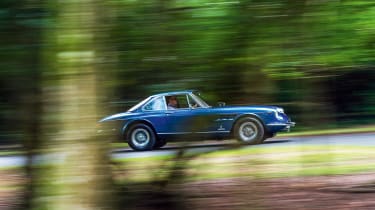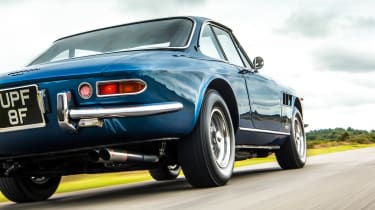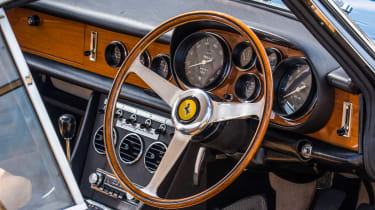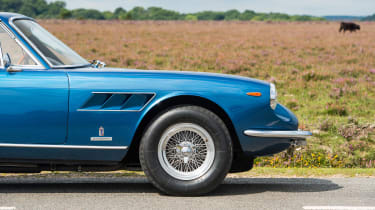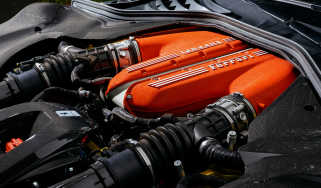1966 Ferrari 330 GTC review – a racing brute in a fine suit
Less revered than its racier siblings, the 330 GTC was the sort of car that Enzo himself would drive – a GT with the beating heart of a racer
It doesn’t matter how many times you hear a ‘Colombo’ V12 reaching its sweet spot, the reaction is always the same: eyes widen, pupils dilate and language tends to take a turn for the fruity. ‘Our’ Ferrari 330 GTC is nothing if not choral, but that’s only part of its appeal. This is among the finest GT cars of its generation; one that effortlessly marries performance and practicality with looks to die for. It is everything you want a ’60s Maranello road car to be and more. Which rather begs the question: why aren’t its praises sung as loudly as those of other models in the marque cannon?
Classic Ferraris, by definition, are lauded. It goes with the territory. But there is a pecking order. As such, the understated front-engined GT cars don’t tend to get talked up in the same way as the test-your-nerve hypercars, the competition machines or the early, coachbuilt confections. The restrained-of-style stuff tends to get pushed to the margins, but in so many ways this is the core appeal of the 330 in any of its various guises. You’re not exactly tripping over them at marque events and there almost seems to be a clique within a clique – stopping well short of inverted snobbery – that wants to promote the various iterations but equally doesn’t want to share what a good thing they are on to.
Consider this: in period in the UK, a 330 GTC cost £6156 after purchase tax. And a 275 GTB/4? Exactly the same amount. Nowadays, a needs-nothing GTC will set you back in the region of £500,000, whereas its more exalted sibling will be more than twice as much. It isn’t twice the car, that’s for sure. But then value is relative. What to one man is the bargain of a lifetime to another is a treasure beyond price.
The 330 GTC really is a fab thing, too, being essentially a medley of ’60s Ferrari greatest hits. Introduced at the March 1966 Geneva motor show, and slotting in neatly between the 275 GTB and the Tom Tjaarda-styled 330 GT 2+2 within the line-up, the new sub-species borrowed its short wheelbase (2400mm/94.5in) frame and independent rear end from the former. This was an excellent choice, the GTB proving itself in competition by taking class honours in the Le Mans 24 Hours (and placing eighth overall) just a few months later, the only Ferrari to finish the endurance classic that year.
The 330 GTC’s outline was naturally the work of regular collaborator and foil, Pininfarina. There was a degree of familiarity with other models, the front end being pure 500 Superfast, the rear end having been lifted wholesale from the 275 GTS (see also the firm’s one-off Chevrolet Rodine show stopper). Only the centre section was anything like original but, if you’re going to plunder a back catalogue, Pininfarina’s is about as good a place to start as any. Although the Turin styling house was once famously reluctant to attribute acknowledgment to any one individual – there’s no ‘I’ in team and all that – ex-Cisitalia man Aldo Bravarone has latterly been credited with shaping the 330 GTC. His résumé also included the 400 Superamerica Coupé Aerodinamico, 500 Superfast and Dino Berlinetta Speciale, which foretold the 206 GT production car.
Beneath the skin, the 330 GTC was similarly a mixture of something borrowed, something new. Period factory literature claimed a useful 300bhp from the enduring V12. Considering manufacturers’ penchant for ‘fine-tuning’ power output figures in period (or just randomly plucking a number out of the air), this is perhaps a little fanciful. Even so, the ‘Tipo 209/66’ unit was a gem. With a displacement of 3967cc, blocks, heads and crankcase were cast in alloy but with iron liners in the block and a seven-main-bearing crank honed from solid steel billet: this was a hugely exacting and labour-intensive method of construction. Chain-driven – naturally – with single overhead cams per bank, carburation was by three twin-choke Weber 40DFIs straddling the 60-degree vee; with a compression ratio of 8.8:1, Ferrari also alleged a more than useful 288lb ft of torque at 5000rpm.
As with most Ferraris of the period, the 330 GTC’s design blended contemporary technology with time-honoured practices. Mounted, like the engine, on rubber bushes to reduce vibration, the five-speed transmission sat in unit with the spiral- bevel final drive at the rear, with engine and transaxle joined by a torque tube. Suspension was by double wishbones, co-axial springs and Koni dampers all-round (with an anti-roll bar at either end), there were large disc brakes front and rear, and the steering was by worm-and-roller. The steel body was welded and bolted to the ladder/perimeter frame combo with a tendril-like multi-tubular structure giving supplementary support.
Performance claims weren’t outlandish: a top speed of 152mph and 0-60mph time of 6.5sec, with independent tests recording standing quarter-mile times in the mid-14sec range. And the press loved it, with Car & Driver reporting: ‘The GTC is a tasteful blend of the mean-and-low look of Ferrari competition GT cars, with the elegance of super-luxury street Ferraris of the past. Detail work, finish, panel fit, every aspect is superlative.’
Former works Ferrari driver Paul Frère, meanwhile, eulogised in Motor: ‘In handling, the 330 GTC is exactly like all the Ferraris I have driven before. It is close to being as neutral as one could want but the most impressive feature of the handling of the new vehicle is the solidness with which it changes direction, particularly in S-bends, where it tracks with about the same precision as a modern race car.’ Coming from a former Le Mans winner, that was high praise. The Belgian ace went on to record two high-speed runs, with 146mph being the quicker of the two, but noted that on both occasions there was still more to come when he was obliged to back off due to the inconsiderate appearance of other road users.
Just as night follows day, the GTC bore an open version, the 330 GTS being aimed squarely at the lucrative Stateside market. Mechanically identical to its fixed-lid brother, the spyder was 110kg heavier at 1408kg, slightly slower at 146mph all-out, and considerably more expensive, with a $15,000 price tag in the US. Partly as a consequence, just 100 soft-tops were sold, compared with around 600 coupés.
Of these, just 22 closed cars were configured in right-hand drive, this particular example being about as good as they get: not concours-perfect, just highly presentable and enjoyed as its makers intended. Bill and Sara Billett have owned the car for the past 13 years and exercise it regularly, which is reflected in the way the Ferrari drives. It’s a corker.
The 330 GTC is commendably free of stylistic tinsel, with brightwork only adding to the sense of elegance rather than detracting from it. The real power here is that of restraint. The car’s long, imperious nose, gaping maw and tusk-like quarter- bumpers lend it presence, the high waistline tapering into the understated rear, all topped by an expansive glasshouse with spindly pillars for panoramic all-round visibility. Riding on Borrani wire wheels with three-ear spinners, it really is magnificent.
It is surprisingly dainty, too. Photos do not lend a sense of scale. The 330 GTC is just 1626mm (64in) wide, which makes it three inches narrower than a not-exactly- elephantine Dino 206 GT. It is also 4505mm (177.4in) long and stands just 1214mm (51.7in) off the deck so doesn’t take up a lot of acreage. Nevertheless, real thought went into the packaging. This is a proper gran turismo with all that entails.
For starters, there’s no need to stoop and generally flail into the driver’s seat, unlike with so many other cars of this ilk. It’s an inviting cabin, too. One of the first things you notice is that the dashboard’s veneer has a gloss sheen rather than the factory original matt finish, which always cheapened the mood. Otherwise, it is completely standard. The instruments are helpfully laid-out, unlike in some of its period rivals, with a large white-on-black Veglia speedo and rev-counter mounted directly in front of the driver within an ovoid binnacle, oil pressure and temperature gauges sited between them. Other dials in the centre of the dash, however, appear a little lost and aren’t altogether easy to read at a glance, while the bank of toggle switches on the centre console are baffling without familiarity. The Nardi wheel is at the expected bus-like angle, prompting the usual arms straight, knees slightly splayed driving position. You barely notice this after a while.
The drama associated with firing old Ferraris never fails to amuse (so long as the car actually starts), but here there are no histrionics. The V12 bursts into song, producing noise of the best kind and lots of it. In fact it’s hard to resist just sitting there, flexing the throttle and revelling in the moment. As is typical of this era of Ferrari, the GTC has a dog-leg first. Press in the barely yielding, single-plate clutch, ease into gear and note how immediate is the throttle response. Shift into second with a slight ker-klunk against the spring bias – the transmission oil isn’t warm yet and it’s a transaxle so there are long linkages – and it’s easy to feel intimidated by the baulking of metal connecting with metal.
More speed, more revs and shifting from second to third needs to be done forcefully as the gearchange doesn’t really respond to delicacy. Ferrari used Porsche synchronisers (and shift pattern for that matter) and there’s some resistance across the gate, as is to be expected. Third to fourth is lightning-quick, but the mass of the driveshaft at engine speeds has to synchronise as well as the gears, so the procedure may seem a little hit-and-miss until you’ve become accustomed to it. Thankfully you do so quickly.
Acceleration in any gear is immediate: there’s no hesitation or fluffing as the V12 waits to get on cam(s). It sounds glorious, too, all bluster and fizz, the desire to hear it rear up on the over-run as you blip on down-changes being all too hard to resist. Childish, perhaps, but life-affirming. Let it stray into the upper reaches (the red line is at 7000rpm) and the rumble becomes a bellow becomes a scream. When cruising, on the other hand, it’s certainly audible but never intrusive, only tyre-roar and buffeting from the A-pillars detracting from the sense of refinement.
What does come as a surprise, as a shock even, is how racy the GTC feels – infinitely more so than most of the preceding 250-series of road cars. Aboard, say, a 250 GTE, or even a Lusso, a certain degree of physicality is demanded for fast progress cross-country. That isn’t the case here. You’re aware of sitting near the rear wheels due to the short wheelbase and you can feel how well controlled they are, the tail never threatening to shimmy. What’s more, unlike the earlier GTs that were set up to understeer, the shorter-wheelbase 330 GTC feels temptingly neutral, in part thanks to its ideal 50:50 weight distribution with a full tank of petrol.
That said, the controls are weighty at low speeds, just to remind you that this seductive coupé is still a 1960s Ferrari. The unassisted steering is initially leaden, with poor lock even by the standards of the day, though that’s forgotten once you’re up to speed. The sense of weight dissipates and the 330 GTC steers neutrally, if not quickly, with negligible kickback. It doesn’t feel particularly skittish over undulating surfaces, either. In its day, the disc brake set-up came in for criticism but it’s hard to see why. There are two huge Bonaldi Master Vac duplex servos – one for the front circuit and one for the rear – and they feel over-sensitive at a slow pace, but their bite is reassuringly accurate and easy to modulate at higher speeds. This is the sort of car that you can have fun playing with, light years more biddable than comparable Astons and Maseratis of the day.
This particular 330 GTC was driven extensively at the time by former Scuderia Ferrari alumnus Mike Parkes. The husband of an old flame loaned Parkes the car while he was convalescing in Northamptonshire following his ghastly ’67 Belgian Grand Prix shunt, but then ‘Parkesi’ had helped develop the model so it was fitting. You can just picture the lofty driver/engineer blatting around the B-roads of the East Midlands, the car’s thoroughbred V12 wailing its heart out as other road-users dived for cover. Evocative stuff.
Which is how it should be, for this era of Maranello GT conjures images of international playboys and their playmates three-figuring their way to the latest hotspot of the beautiful people; of crossing continents in a single bound; of trumpeting your arrival from a mile away, perhaps more depending on wind conditions. Nevertheless, the 330 GTC still plays second string to the likes of the 275 GTB with which it shares so much of its DNA.
It deserves a wider retinue, that’s for sure. In many ways, this beguiling super-coupé is that rarest of things: an underrated Ferrari, but not for much longer, surely.
With thanks to owners Bill and Sara Billett.
This original content was published in issue 002 of ENZO Magazine





